9 Doctor Website Design Examples that Attract Patients
A well-designed doctor website is essential for every medical business in the modern digital era. A private practice’s website frequently serves as their initial point of contact with prospective clients. Consequently, a website’s design that prioritizes the needs of their patient may greatly improve user experience, foster confidence, and increase conversion rates.
In this post, we’ll look at 9 medical websites that put a strong emphasis on patient-centered design and go over recommended practices for making successful medical websites
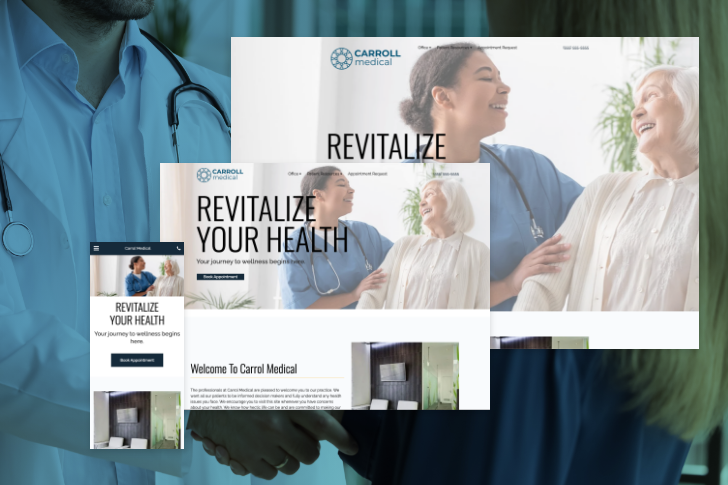
Why Patient-Focused Design Matters
Enhancing User Experience
A patient-focused website design is essential for enhancing user experience. A good doctor website should have clean design, easy navigation, mobile-friendliness, responsiveness, and search engine optimization, ensuring potential patients can find the information they need quickly.
A well-designed website improves navigation, making it easier for users to browse through services, read about the doctor, and book appointments. This not only enhances user satisfaction but also increases the likelihood of patients returning to the website.
Building Trust and Credibility
A professional and patient-focused website design builds trust and credibility with potential patients, making it a good doctor website. First impressions matter, and a clean, well-organized website can convey a sense of professionalism and care.
Features such as patient testimonials, detailed information about medical, and educational content can help build trust and establish the practice as a credible and reliable healthcare provider.
Improving Conversion Rates for Prospective Patients
Effective website design can lead to higher conversion rates. Clear call-to-actions (CTAs), easy-to-find contact information, and streamlined appointment booking processes make it easier for potential patients to take the next step.
By focusing on patient needs and providing a seamless online experience, practice can increase appointment bookings and inquiries, ultimately growing their practice.
Key Elements of Effective Medical Website Design
Clean and Professional Layout
A clean and professional layout with just the right amount of design elements is crucial for making a positive first impression for website visitors. The website should have a visually appealing design with a clear structure that guides users through the menu items, content and health services section.
Avoid clutter and ensure that important information is easily accessible. Always include social media icons and links, and consider a google map. Here’s an example of a clean layout:
Mobile Responsiveness
In today’s world, most people access websites via their mobile devices, making it crucial for practice websites to incorporate effective web design that is both mobile and desktop friendly. A mobile-responsive design ensures that your website adapts seamlessly to different screen sizes, providing an optimal viewing experience whether patients are browsing on a smartphone, tablet, or desktop.
Prioritizing mobile design ensures that users have a smooth and intuitive experience, no matter how they access a site. This approach not only enhances user satisfaction but also boosts a site’s SEO ranking, as search engines favor mobile-friendly websites. Here’s an example of a responsive design:
Easy Navigation
Healthcare practices require intuitive navigation to ensure patients can find the information they need. The navigation menu should be simple and organized, allowing users to find the information they need without any hassle.
Consider using a drop-down menu for different services your practice offers and include a search bar for quick access. Here’s an example of easy navigation:
Mobile Responsiveness
With the increasing use of mobile devices, having a mobile-responsive design is more important than ever. A mobile-friendly website ensures that users have a seamless experience regardless of the device they are using.
Responsive design adapts the website layout to fit different screen sizes, providing a consistent user experience. Here’s an example of a responsive design:
Patient Testimonials
Healthcare professionals’ testimonials play a crucial role in building trust in the best medical websites. Featuring testimonials on the website can provide social proof and reassure potential patients about the quality of care.
Include testimonials in a prominent location, such as the homepage or a dedicated testimonials page. It’s also helpful to pair the testimonials with a delightful image that reinforces the positivity. Here’s an example of embedded testimonials:
Clear Call to Action (CTAs)
Clear and compelling CTAs (call to action) are vital for guiding users towards taking action. Whether it’s booking an appointment, signing up for a newsletter, or contacting the practice, call to action buttons should be prominently displayed and easy to find within a neat layout.
Use action-oriented language and ensure that CTAs stand out visually and convert site visitors into more patients. Here’s an example of effective CTA placement:
9 Patient-Focused Practice Website Design Examples

1: W Dermatology
Website: W Dermatology
Feature to Note
W Dermatology website features a page dedicated to showing the results of the before and after photos of patients as well as highlight the transformative care as a result of the procedure the medical practice administers.
By showcasing the results, the practice is able to highlight another level of transparency, which can help ease the anxiety of potential patients.
This personalized approach not only makes the website memorable but also distinctive, with the choice of visuals which in turn cultivates a feeling of comfort and trust encouraging patients to choose their practice knowing they are in safe hands.
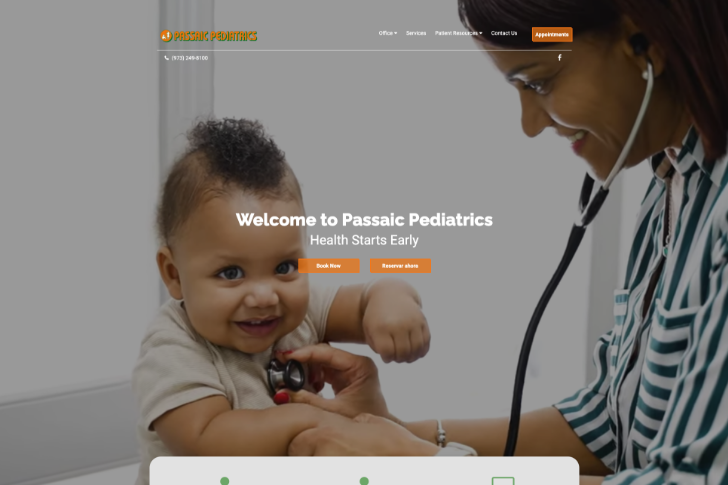
2: Passaic Pediatrics
Website: Passaic Pediatrics
Feature to Note
Passaic Pediatrics’ website has a Spanish translation incorporated in their website for certain CTA buttons. Removing the language barrier that may bar others from receiving the care they need.
Which in turn makes it easy to book appointments and filling out request forms which helps streamline the process for patients to schedule their visits.
This convenience enhances the user experience for patient receiving and can lead to higher conversion rates, as patients are more likely to complete the booking process when they don’t have a language barrier making it both simple and accessible.
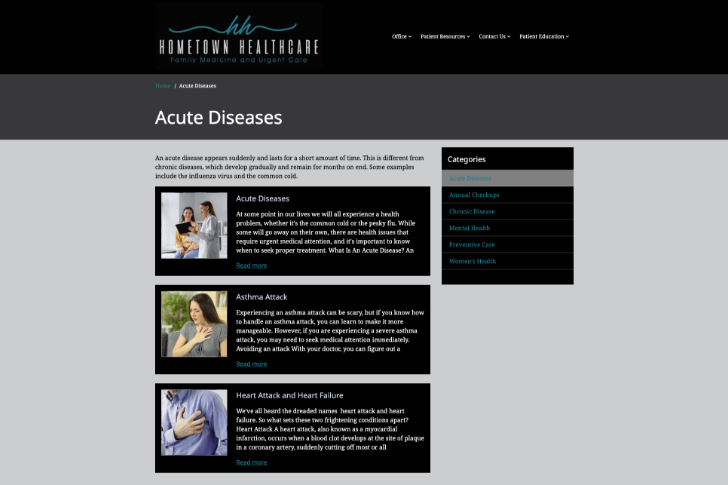
3: Hometown-Healthcare Family Medicine and Urgent Care
Website: Hometown-Healthcare Family Medicine and Urgent Care
Feature to Note
Hometown-Healthcare Family Medicine and Urgent Care excels in patient education through its dedicated educational forum, which highlights the range of medical services offered. This section features a comprehensive library of articles and provides answers to common concerns, providing round-the-clock access to valuable information about medical care and general wellness.
By offering educational resources on various conditions, treatments, and preventive measures, the website empowers patients with knowledge, helping them make informed decisions about their health. This focus on education not only builds trust but also positions the practice as a knowledgeable and reliable partner in patient wellness.

4: Carl Christensen, MD
Website: Carl Christensen, MD
Feature to Note
Carl Christensen, MD website features an FAQ section that addresses common patient questions comprehensively. This section provides detailed answers on the conditions they treat, booking, and how to book an appointment.
By offering thorough explanations, the FAQ section helps make this information more accessible and understandable for potential patients. This focus on patient education builds trust and credibility, as it shows the practice’s commitment to transparency and patient empowerment.
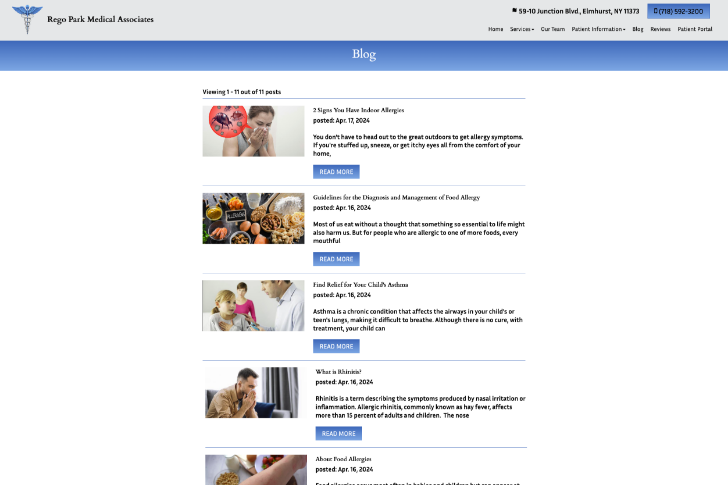
5: Rego Park Medical Associates
Website: Rego Park Medical Associates
Feature to Note
Rego Park Medical Associates features an active blog section that regularly publishes articles on various health topics. This commitment to providing fresh, relevant content helps keep patients informed about patient care, general wellness, and specific health issues.
By sharing knowledge through blog posts, the practice positions itself as a thought leader in the field, fostering a sense of community and engagement. This continuous flow of information not only educates patients but also enhances SEO, helping the website rank higher in search engine results and attract more visitors—a crucial element of online marketing.

6: Vitalife Coastal Infusion
Website: Vitalife Coastal Infusion
Feature to Note
Vitalife Coastal Infusion’s website features an in-depth “About Us” section that highlights the character and background of Dr. Will Carlson, M.D. as well as his colleagues, emphasizing the expertise and approach of the medical professionals. This section provides a comprehensive narrative about Dr. Carlson’s journey into primary care and sport medicine, his professional philosophy, and his personal interests.
By sharing his story and values, as well as showcasing the rest of his dedicated team, the website design creates a personal connection with potential patients, making Dr. Carlson and his colleagues more relatable and trustworthy. This detailed portrayal helps to humanize the practice, fostering a sense of familiarity and comfort, which is crucial for building long-term patient relationships and attracting potential clients.
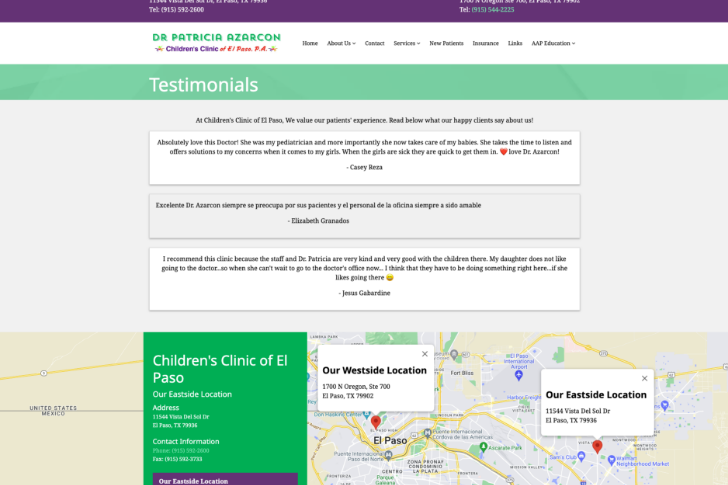
7: Dr Patricia Azarcon
Website:Dr Patricia Azarcon
Feature to Note
Dr Patricia Azarcon’s website features an extensive reviews section that showcases testimonials from satisfied patients. These firsthand accounts provide social proof of the quality of care offered by Dr. Anderson and his team.
By highlighting diverse experiences and positive outcomes, the reviews build trust and credibility, making potential patients feel more confident in choosing this practice. This transparency in showcasing patient feedback not only enhances the practice’s reputation but also demonstrates a commitment to patient satisfaction and continuous improvement.

8: Pediatrics of Central Florida, P.A.
Website: Pediatrics of Central Florida, P.A.
Feature to Note
Pediatrics of Central Florida, P.A.’s website engages prospective patients with a captivating video on the homepage. This video integration provides an overview of the services offered and highlights their dedication to patient care, creating a personal connection with potential patients.
Video content is a powerful tool for conveying information quickly and effectively, and it helps to humanize the practice by showcasing the friendly and professional environment—a great way to attract more patients. By using video, the practice can better capture the attention of visitors, increase engagement, and make a lasting impression.

9: Retina and Diabetic Eye Center, PA
Website: Retina and Diabetic Eye Center, PA
Feature to Note
Retina and Diabetic Eye Center, PA’s website features an easy-to-use appointment request form that streamlines the process for patients to schedule their visits. By providing a straightforward and user-friendly form, the website ensures that potential patients can quickly and easily book appointments without the hassle of phone calls or emails.
This convenience enhances the user experience for patient receiving and can lead to higher conversion rates, as patients are more likely to complete the booking process when it is simple and accessible. The clear instructions and responsive design further contribute to a seamless and efficient appointment scheduling experience.
Best Practices for Patient-Focused Design in Healthcare Professionals’ Websites
Understanding Your Patient’s Needs
Knowing your target audience is the first step in creating a patient-focused website for medical practices. Understand their needs, preferences, and common concerns. Tailor the website content and design to address these aspects, ensuring that patients feel understood and valued.
Create your medical site with an ideal patient persona in mind, a conglomeration of traits, needs, and wants of your best clients and potential clients you want to attract. Think about the medical services they are looking for, the important elements that will resonate: a professional looking simple layout, attractive images, pleasing color scheme, testimonials section.
Using a persona can help guide you to your ideal potential client, and lead to more positive reviews because your marketing efforts are more focused to create and deliver a specific experience.
Prioritizing Accessibility
A professional designer is crucial for ensuring that all users, including those with disabilities, can navigate and use the website effectively. Implement features such as alt text for images, keyboard navigation, and screen reader compatibility to make the website accessible to everyone.
Color scheme, font choices, and design inspiration also become a very important way to convert visitors. It is important in an effort to stand out to still employ best practices for accessibility with these aesthetic elements. There are a number of free online tools to scan your website and flag any accessibility issues.
Using High-Quality Images
High-quality images can significantly enhance user engagement. Use professional images that reflect the practice’s environment, services, and staff. Avoid generic stock photos and opt for images that convey authenticity and professionalism.
A quality, compelling hero image (a full width hero image is ideal) gives your site credibility at first glance. Pair it with a clear and captivating headline and brief description to attract new clients, and introduce them to your various services. To view Officite’s entire gallery of website templates specific to private practices, please fill out the form below.
View Our Medical Website Designs & Packages
Keeping Content Updated
Regularly updating the website content is important for keeping it relevant, informative, and useful for search engine optimization. Ensure that information about services, staff, and contact details is up-to-date. Additionally, consider adding a blog section to share news, tips, and educational articles related to patient care.
Quality, relevant content is a marker of the best medical website, serving current and potential patients, placing in search engine rankings, and drawing more leads
Ensuring Fast Load Times
Website speed is a critical factor for user experience and SEO of any good website. Optimize images, use efficient coding practices, and leverage content delivery networks (CDNs) to ensure fast load times. A slow website can frustrate users and lead to higher bounce rates.
In addition to optimizing images and coding, consider minimizing the use of heavy scripts and plugins that can slow down your site. Regularly monitor your website’s performance using tools like Google PageSpeed Insights or GTmetrix to identify areas for improvement. Implementing these practices not only enhances user experience but also boosts your website’s search engine rankings, as search engines prioritize faster-loading websites.
Conclusion
A patient-focused medical website design is essential for attracting and retaining patients. By enhancing user experience, building trust, and improving conversion rates, a well-designed website can significantly benefit a private practice. We hope these examples and best practices inspire you to evaluate your own website and implement patient-focused design elements.
At Officite, we specialize in creating customized, patient-focused websites for private practices. In addition to being a website provider, our team of experts understands the unique needs of doctors and their patients, ensuring that every website we design not only looks great but also performs exceptionally well. We are a one-stop online marketing solution.
Whether you need a complete website overhaul or specific enhancements to your existing site, Officite can help you achieve your goals and elevate your online presence.

Maryrose Dooley expertly guides small practices through the digital landscape, offering marketing strategies to attract more patients. Her unique blend of business acumen and design expertise creates visually appealing solutions that set businesses apart. With a passion for leveraging technology, Maryrose helps businesses of all sizes achieve their goals and stand out from the competition.



